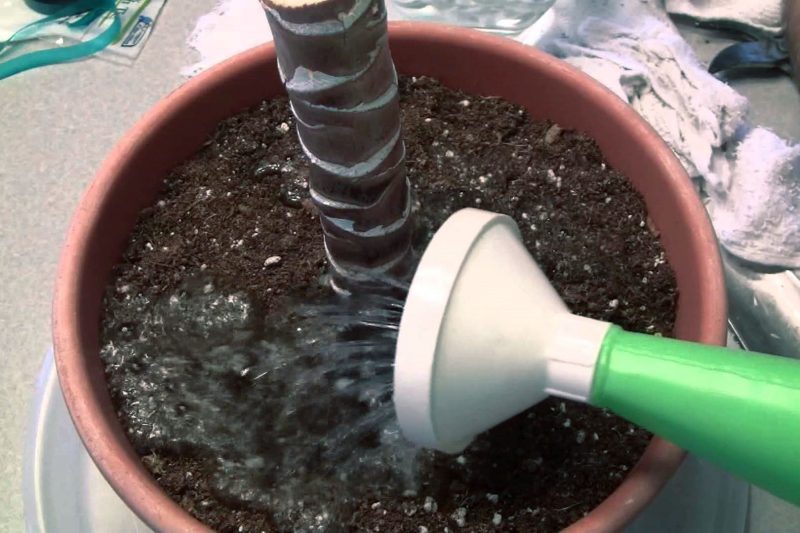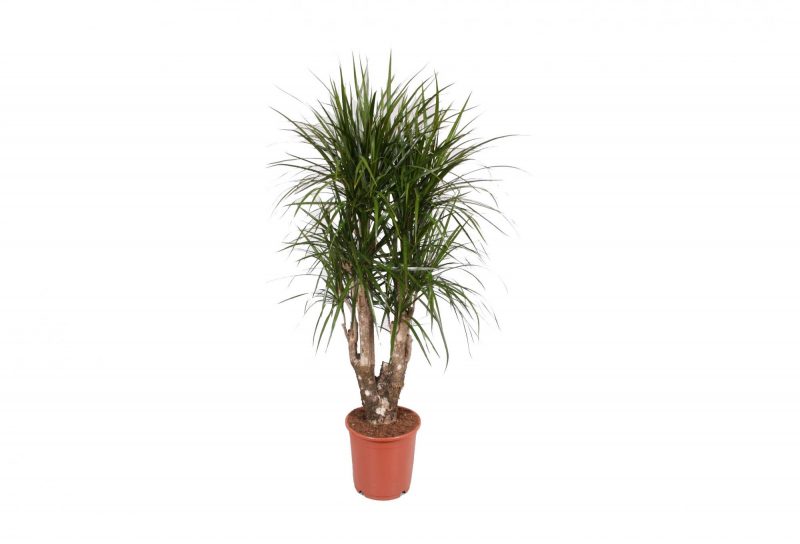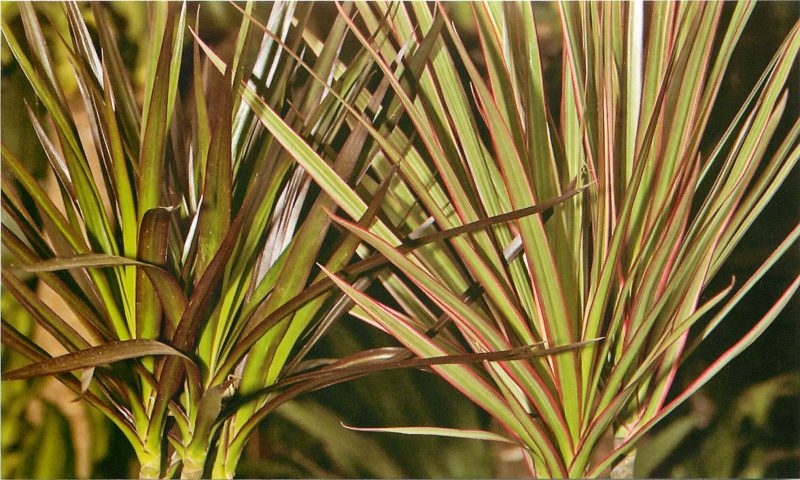Dracaena is popular for its slender shoots that make dense whorls of elongated leaves. This plant is not only highly decorative, but also unpretentious, differs in simplicity and variability of breeding. At home, the reproduction of dracaena is carried out by cuttings and layering. Rare varieties are grown from seeds.
Material Content:
Dracaena: propagation by apical cuttings
New instances of dracaena can be obtained from cuttings, which are used as tops of shoots ending in leaf rosettes.

The slice is performed with a sharp tool, strictly across the stem, departing from the lower tier of the leaves 15 to 20 cm. The juice released on the surface of the slice is dried with porous material and poured with garden varnish, paraffin or sprinkled with crushed coal.
Cuttings, dried and rooted in water or substrate.
- Shredded activated carbon is added to the water. To activate the growth processes - a few drops of the drug, stimulating the growth of roots.
- As a soil, it is convenient to use vermiculite, perlite, a ready-made substrate for growing decorative palms, or to make a mixture of equal parts of peat and sand.
The choice of rooting method is determined by the personal preferences of the grower, and does not affect the rate of root formation.
Regardless of the method chosen, cuttings organize greenhouse conditions:
- close with a transparent airtight cap (bag);
- placed in a warm (22 - 25 ° C) and slightly darkened place.
Rooted cuttings are taken care of:
- daily air;
- sprayed with warm, settled water;
- Water is changed once a week, and when using a substrate, it is watered, avoiding overmoistening of the soil.
The roots are formed for a long time - 1.5 - 2 months. When they grow to a length of 1-1.5 cm, small dracaenas are planted in separate containers and taken care of as adult forms.
The mother plant is reanimated:
- placed in a warm and bright place;
- for a cropped shoot, an impromptu greenhouse is arranged from a plastic bag;
- the plant is periodically sprayed and moderately watered.
After 3 to 4 weeks, they will wake up on the trimmed shoots and go to the growth of the kidney, giving the plant a second life.
Propagation of an indoor flower by cuttings from the stem
Propagation of dracaena at home is also possible by cuttings.

This is relevant if, after a planned pruning or harvesting of apical cuttings, long shoots remain. They are divided into sections of 7 - 10 cm, conducting sections along the scar (the place of attachment to the trunk of the sheet).
The stem cuttings root in exactly the same way as the apical ones, but with one addition. In the substrate, the stem cuttings can be placed horizontally, slightly deepening into the ground. With this arrangement, the buds first wake up on the shoot, and then the roots grow.
How to propagate a plant by air layers
If the dracaena is small and not yet subject to cuttings, then it can be propagated by layering.
For this:
- In spring or at the very beginning of summer on the shoot, under the scar, an incision is made 1/3 of the trunk width.
- A part of a match or a toothpick is inserted into the slice - this will prevent its overgrowth.
- Part of the shoot around the incision is covered with a layer of sphagnum, which is sprayed with water and fixed with waterproof material (for example, plastic wrap).
- The moss is periodically checked for moisture; if necessary, it is irrigated from the spray gun.
- After growing roots with a length of 0.5 - 1 cm, the shoot is cut off and planted in a pot in a permanent place.
The method of propagation of dracaena seeds
The indoor flower of dracaena does not bloom at home, so it is impossible to obtain seeds on its own. If you managed to get them, then do not hesitate.

- Before planting, the seeds are treated by soaking in a solution of any growth stimulant drug (Epin, Zircon) for 10-15 minutes. This will accelerate their germination.
- After processing, the seed is slightly dried and distributed on the surface of the moistened mixture, composed of equal parts of peat and sand, and then sprinkled with soil.
- The container with crops is covered with a transparent, airtight material, placed in a warm (20 - 25 ° C) bright place.
- Before emergence, seedlings are aired daily and, if necessary, slightly moisten the soil.
Shoots will appear in about 1 - 1.5 months. After the appearance of the first sprouts, the protection is gradually removed from the container. The grown and stronger seedlings dive into small pots.
Seed propagation is characterized by duration and laboriousness, therefore this method is used much less often, if necessary, to obtain a large number of new varietal forms.
Flower Transplant Rules
One element of dracaena care is transplantation.

The need for its implementation in adult forms is determined by the following features:
- The flower has just been purchased, and it is in a fragile plastic container, unsuitable for long-term plant growth.
- The roots of dracaena completely filled the entire volume of the container and peep through the drain holes.
- The flower is flooded and needs urgent replacement of the substrate.
A dracaena transplant is performed at the very end of winter or spring, having prepared everything necessary:
- A new and large container with a diameter of 2 - 3 cm with a capacious drainage compartment and drain holes. The material from which it is made does not matter, but the shape is important. It is desirable that the new pot resemble a glass and be stable.
- Drainage - expanded clay, chipped brick or fine-grained river sand.
- Fresh substrate with a neutral environment.Soil for adult forms can be bought or collected independently, using one of the options for its composition. Sod, leaf, compost land and peat (2: 1: 1: 0). Garden land, peat and sand (3: 2: 1). Peat, humus and sand (2: 1: 1).
During the procedure, adhere to certain rules:
- 2 - 3 days before transplanting the plant is not watered, this will allow painlessly extracting the plant from the old pot.
- An earthen lump is freed from the soil and carefully inspected by the roots, all dubious areas are removed and cuts are crushed with coal.
- The plant is placed in a new container, with pre-poured drainage and a small amount of soil. The voids are covered with the remaining soil, without adding 1.5 cm to the edges of the pot, and lightly tamping the soil at the base of the shoot.
- The transplanted plant is watered.
Aftercare for Dracaena
After transplanting, the dracaena needs at least 2 weeks to adapt to the new pot and restore the root system. At this time, the plant is best placed in the shade and protected from drafts.

In the future, the flower is looked after the same way as before the transplant:
- moderately watered, using well-defended water and preventing drying of the entire earthen coma and fluid stagnation in the pan;
- daily sprayed and periodically, for hygienic purposes, arrange a plant for showers;
- protect from direct sunlight;
- from March to November, once every 2 weeks, they feed, alternating the use of mineral and organic fertilizers dissolved in water;
- in order to form a decorative crown, shoots of a plant are cut in spring.
Proper care and timely transplantation of dracaena will allow you to get a highly decorative plant that can decorate any interior.













